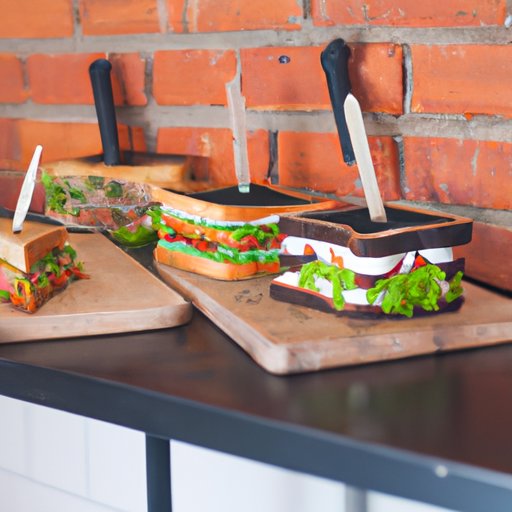The Art of Sandwiching: A Comprehensive Guide
Sandwiches have been a popular food choice for centuries, known for their convenience and versatility. Whether it’s a quick snack, lunchtime staple, or a meal on-the-go, sandwiches have become a cultural staple in many countries. But sandwiching isn’t just about putting two slices of bread together with some filling in between, it’s an art that requires proper layering and ingredients placement. In this article, we’ll guide you through the nuances of sandwich making and highlight its versatility with healthy and creative twists.
The Art of Sandwiching: How to Perfectly Layer Your Ingredients
Assembling a sandwich that is not only delicious but visually appealing is an art that requires the proper layering of ingredients. The basic construction of a sandwich includes two slices of bread with a variety of fillings, including meat, cheese, vegetables, and condiments. However, the key to making a perfectly layered sandwich is in the arrangement of these ingredients.
Start by selecting the type of bread that will complement your filling choices. Avoid slicing the bread too thick or too thin, as it can affect the overall texture and taste of the sandwich. Next, it’s important to spread the condiments evenly on both slices of bread to avoid overwhelming one side with too much flavor.
When it comes to layering the meats and vegetables, start with the driest ingredients and work your way up to the wetter ingredients. This will prevent the bread from becoming soggy and will ensure that each bite has a mix of flavors and textures.
Lastly, cut the sandwich diagonally or into smaller portions for a visually appealing and easy-to-eat meal or snack.
Why Sandwiching is the Ultimate Lunch Hack for Busy Professionals
For many busy professionals, finding the time to prepare a healthy and satisfying meal can be challenging. Sandwiches offer a convenient and portable meal option that can be prepared in advance or quickly put together during a busy day.
Sandwiches are also a budget-friendly option and can be made with a variety of ingredients depending on personal preference. Their versatile nature makes them a perfect meal choice for those following dietary restrictions or preferences, such as vegetarian or gluten-free.
To add more variety to your lunch routine, try incorporating creative and quick-to-prepare sandwich ideas such as a Hawaiian-style BBQ chicken sandwich or a vegan chickpea salad sandwich.
The Sandwiching Trend: Exploring Different Filling and Bread Combinations
Sandwiches have become a staple in many cultures around the world, each with its own unique filling and bread combinations. In the United States, the classic peanut butter and jelly sandwich and the Philly cheesesteak are among the most popular options. In France, the croque monsieur, a grilled ham and cheese sandwich, has become a national dish.
To add a unique twist to your sandwich, experiment with different ingredients and bread options. For example, try using pita bread or naan instead of traditional sliced bread, or incorporate fresh herbs for added flavor.
Another idea is to use leftovers from previous meals, such as grilled chicken or roasted vegetables, to create a quick and easy sandwich. The possibilities are endless, and experimenting with different flavors and textures is one of the joys of sandwiching.
Healthy Sandwiching: Easy Ways to Create Delicious and Nutritious Sandwiches
Although it’s easy to fall into the trap of using processed meats and high-calorie condiments, sandwiches can also be a nutritious and healthy meal option. Sandwiches can be made with whole-grain bread, lean protein, and fresh vegetables for a well-balanced meal.
Use turkey or chicken breast as a healthier protein option and add avocado or hummus as an alternative to mayonnaise. Adding fresh vegetables such as tomatoes, lettuce, and cucumbers, not only provides added nutrients but also adds texture and crunch to your sandwich.
For vegetarian or vegan options, try using tofu, tempeh, or roasted vegetables for added protein. Use flavorful spreads such as pesto, sun-dried tomato paste, or guacamole for added flavor.
From PB&J to Croque Monsieur: A Brief History of the Sandwich
The sandwich has humble beginnings, dating back to the 1st century B.C. when rye bread and cheese were popular among Jewish communities in Rome. It wasn’t until the 18th century that the sandwich gained popularity in England, thanks to the fourth Earl of Sandwich, John Montagu. Legend has it, that he requested a slice of meat between two slices of bread to avoid interrupting his gambling activities, and thus, the sandwich was born.
Since then, sandwiches have become a cultural staple worldwide, with each country adding its unique twist. In the United States, sandwiches such as the Reuben and the BLT have become national treasures. In Vietnam, the Banh mi, a baguette sandwich stuffed with pickled vegetables, herbs, and meat, has become a popular street food.
Sandwiches have evolved from a humble meal option to a treat fit for royalty, with the croque monsieur becoming a national dish in France. No matter the occasion, sandwiches continue to be a beloved food choice for many worldwide.
Conclusion
Sandwiching isn’t just about putting two slices of bread together with some filling in between. It’s an art that requires proper layering and ingredients placement. Sandwiches offer a convenient and portable meal option that can be prepared in advance or quickly put together during a busy day. The versatility of sandwiches means that they can be made to suit individual tastes, dietary restrictions, and cultural preferences. So, next time you make a sandwich, take pride in its construction and enjoy the endless flavor combinations available.
